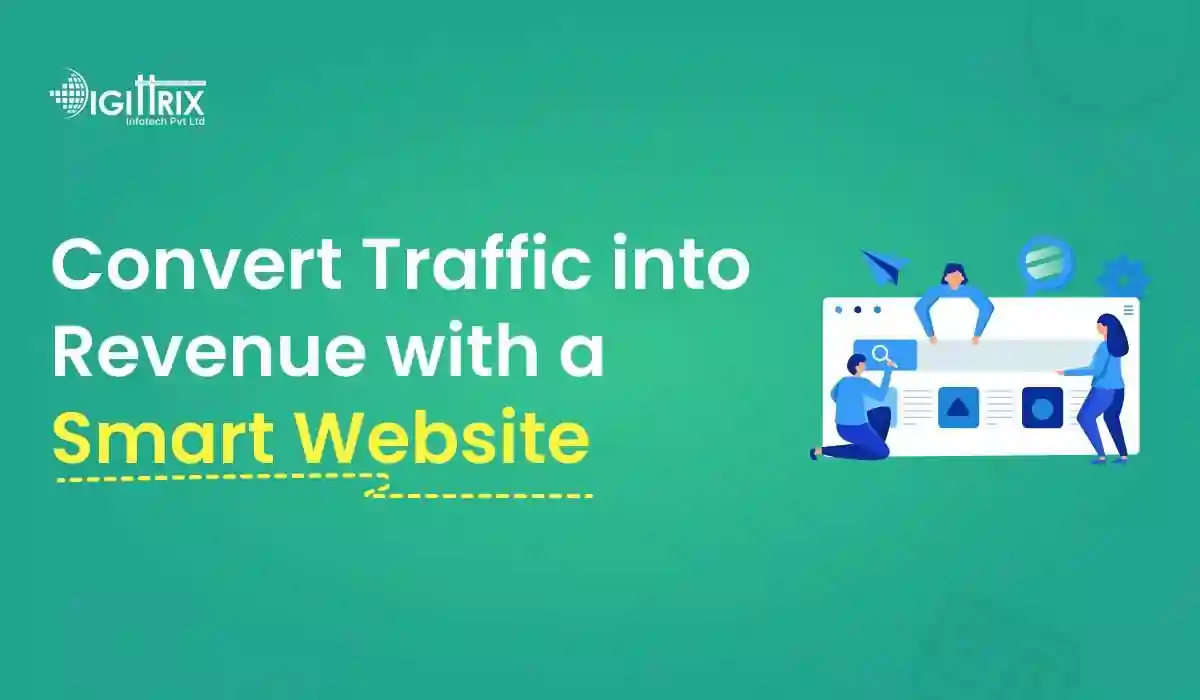A fast, mobile-friendly website helps attract more customers and boost conversions, while poor web design causes most visitors to leave quickly and not return to your site.
Highlights
An enthusiastic developer and skilled business management expert with over a decade of experience in the field

Building a website that effectively converts visitors into customers is important for businesses aiming to thrive in the digital age. A website is often the first impression a potential customer has of your brand. Therefore, it's crucial to design a site that not only attracts visitors but also convinces them to take action, whether it's making a purchase, signing up for a newsletter, or filling out a contact form.
In this comprehensive guide, we will cover the essential elements required to create a website that converts visitors into loyal customers. We will examine various strategies for designing a high-converting website, including the significance of website development, the importance of hiring developers and the advantages of collaborating with an experienced company for custom solutions. WebFX reports that fast-loading websites improve customer conversions by 74% compared to slower sites.
Want to earn online? Explore the 10 best website ideas for making money in 2025 and kickstart your success!
The first step in building a website that converts visitors into customers is to understand your target audience. Without knowing who your visitors are and what they seek, it's impossible to create a site that meets their needs and prompts them to take action.
Once you have a clear understanding of your audience, you can design your website to meet their expectations and needs. This is particularly important when considering the choice of platform. Whether you're using Shopify, WordPress, Magento or building a custom solution with PHP, Python or Java, comprehending your audience aids in selecting the best technologies and features for your website.
A user-friendly design is among the most crucial elements of a high-converting website. If visitors struggle to navigate, they are likely to leave before even considering a purchase or inquiry. The goal is to create a site that is easy to use and intuitive, ensuring visitors can quickly find what they’re looking for without frustration.
Whether you are using React, Vue, or Angular, integrating these technologies ensures that your website’s frontend is interactive and responsive. A professional web development company can help seamlessly integrate these elements into your design.
Website speed directly impacts user experience and ultimately your website’s conversion rate. Studies have shown that users tend to abandon websites that take more than a few seconds to load. Slow-loading pages can lead to high bounce rates, meaning potential customers leave before they even have a chance to explore what you offer.
For e-commerce websites built on platforms like BigCommerce, WooCommerce, or Shopify, speed is crucial for delivering customers a seamless shopping experience. Utilising the appropriate backend technologies, such as Node.js, PHP, or Ruby, can also greatly enhance website performance.
Building trust with your visitors is essential for converting them into customers. When visitors feel assured that your website is secure and credible, they are more inclined to make a purchase or sign up for your services.
Creating a custom website development plan with these features will ensure that visitors feel secure when interacting with your brand. Freelance developers or a website development company specializing in CMS platforms like WordPress or Webflow can assist in implementing these trust signals on your site.
Your website should reflect your brand’s identity. This involves using consistent colors, fonts and styles that align with your company’s branding. A well-designed website with a cohesive visual identity will create a lasting impression on visitors and encourage them to return. Unbounce study finds that 88% of users avoid returning to a website after a poor experience.
If you’re collaborating with custom web developers, they will assist in creating a dynamic design that is both visually appealing and aligned with your brand’s message. Selecting a frontend technology such as CSS, HTML, or JavaScript will further enable you to bring these designs to life.
Your website should communicate what your business offers and why visitors should care. A compelling value proposition can significantly influence converting visitors into customers. Your value proposition should address these two key questions:
Position your value proposition prominently on your website’s homepage, ideally near the top, so visitors immediately understand what your site is about. This is especially important for B2B or B2C websites, where effectively communicating the benefits of your product or service is essential.
Search engine optimization (SEO) is vital for ensuring that your website ranks well on search engines like Google. High search engine rankings facilitate easier access for potential customers to find your site, leading to increased traffic and higher conversion rates.
If you’re using a platform like WordPress, Wix, or Shopify, ensure that SEO plugins and tools are properly integrated. An agency or freelance developer who specialises in SEO can assist in optimizing your site for search engines, ensuring that your website ranks well and attracts more traffic.
For businesses that sell products or services online, developing an e-commerce website is essential. An e-commerce website must offer a seamless shopping experience for visitors, allowing them to easily browse products, add items to their cart and complete the checkout process.
A good e-commerce website development plan includes all these features to ensure customers have a hassle-free shopping experience. You can use platforms like Magento, WooCommerce, or Shopify to build your store, or develop a custom solution using React, Node.js, or Ruby.
Once your website is live, you need to track its performance to see how effectively it converts visitors into customers. Analytics tools like Google Analytics can help you monitor important metrics such as bounce rate, page views, average session duration and conversion rate.
By analyzing this data, you can identify areas for improvement and make adjustments to your website to increase conversions over time. You can utilise AWS or Google Cloud to monitor performance and scale your website as necessary. WebFX research shows that mobile-optimized websites generate 67% more leads than their non-optimized counterparts.
Creating a website that converts visitors into customers is a complex process that demands a combination of design, functionality and strategy. By understanding your audience, providing an intuitive user experience, ensuring your site is quick and incorporating trust-building elements, you can develop a website that motivates action.
Whether you are looking to build a website for a business, launch an e-commerce platform, or offer web development services, the key is to collaborate with professionals who can bring your vision to life. Experienced web developers specializing in custom website development can help turn your ideas into reality. By focusing on performance, design and content, you can create a website that not only attracts visitors but also converts them into loyal customers.
In the fast-paced digital world of 2025, your website isn’t just a static page; it's a powerful tool designed to convert visitors into paying customers. Whether you’re running an e-commerce platform, offering subscription services, or building a membership site, your website needs to be optimized to drive engagement and facilitate conversions.
At Digittrix, we specialize in creating websites that not only attract visitors but also turn them into loyal customers. With over 14 years of experience and a skilled team of developers, we offer web development services that focus on the essential elements of a high-converting website. From intuitive design to seamless navigation and performance optimization, our team ensures your website is built to meet the needs of today’s users and maximize profitability.
If you're ready to create or enhance a website that converts visitors into customers, reach out to our expert project managers today. Call us at +91 8727000867 or email digittrix@gmail.com to get started and turn your website into a high-converting asset.

Do you need help in Web Development ?




Join over 1500+ businesses we've already helped!
A well-designed, user-friendly website with clear calls to action, fast loading speeds, and trust-building elements such as reviews and secure payment options helps convert visitors into customers.
Mobile optimization is crucial, as many users browse and shop on mobile devices. A responsive design ensures a smooth experience, increasing the likelihood of conversions.
SEO ensures that your website is discoverable in search engines, driving more traffic. By using relevant keywords and high-quality content, SEO helps bring in potential customers who are more likely to convert.
E-commerce features like easy navigation, product pages with detailed descriptions, secure payment methods, and an intuitive checkout process are essential for turning visitors into customers on an online store.

©2025Digittrix Infotech Private Limited , All rights reserved.